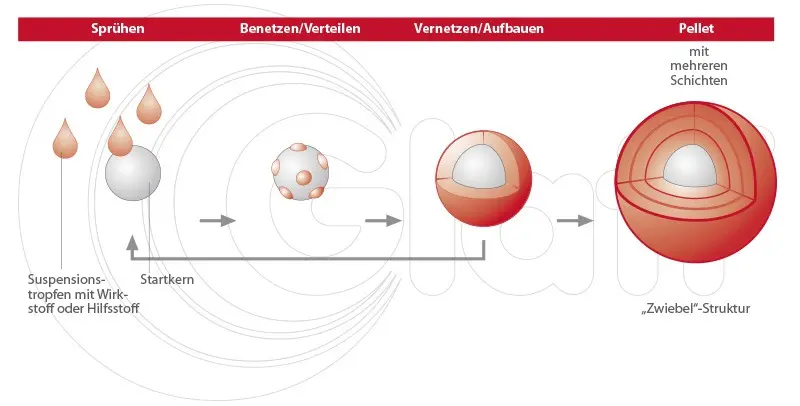Lay it on thick: Layering builds up pellets layer by layer
How does layering work for pelleting? In layering, the active ingredients are applied to pre-coated starter pellets – thicker than in coating processes.
Neutral pellets with a size of 100 micrometers or larger serve as the carrier material. Layering is similar to a film coating process: One or more active ingredients are applied in layers as a solution, suspension or powder. Often, these layering layers are much thicker – the weight gain can be up to several hundred percent.
What are the advantages of layering for your pellets?
Layering technology is used to refine and functionalize active ingredients and active substances. We can achieve a wide variety of properties for the active ingredient or active substance layer by adding suitable additives.
Depending on the requirements profile, we offer the following processes: suspension layering, solution layering and dry powder layering.
Suspension or solution layering – plus coating
This type of layering with a suspension or solution is the most popular process variant for building up pellets. The quality of the coated pellets – their round shape, smooth surface and narrow particle size distribution – depends very much on the active ingredient pellets presented.
Our result with suspension or solution layering: We obtain round pellets with a dense structure and uniform surface. Depending on the active ingredients used, we can optimize them for a wide range of product properties. We round off the process with a film coating.
Suspension layering or solution layering – step by step
- coating the carrier core with a suspension or solution
- spraying on the layering liquid and building up the active ingredient layer with the desired active ingredient content
- in most cases: film coating as a final step after the layering process
Dry powder layering: short process during pellet build-up
This type of layering with a powdered active ingredient is a very efficient process variant for pellet build-up. The advantage of dry powder layering over layering with active ingredient liquids is that the process time is considerably reduced and efficiency is increased.
Our result with dry powder layering: We obtain dust-free, very round active ingredient pellets with a narrow particle size distribution. With optimum process settings, we can achieve up to 300 percent weight application per hour with this layering variant.
For powder layering we mainly use the rotor process
- suction of the microfine active ingredient into the process chamber via a powder nozzle
- fixing the powder to the starter cores with a binding solution

